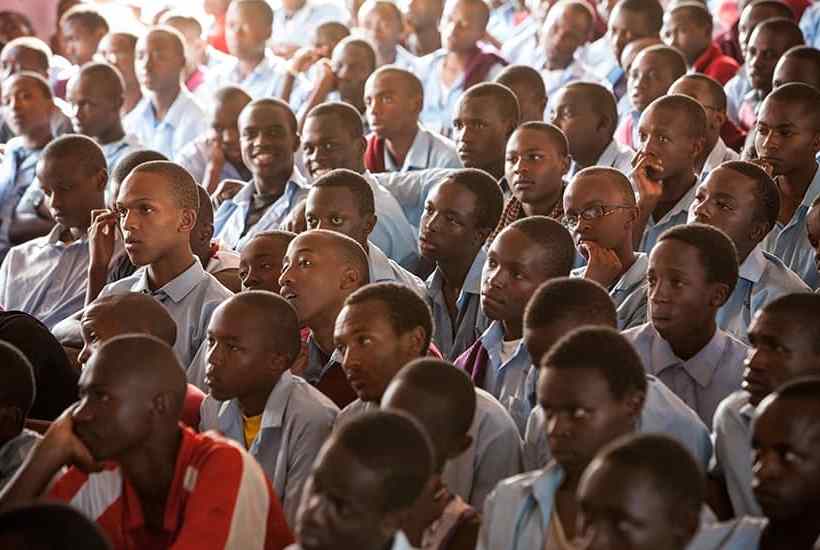Demographers are attached to their theories. The field’s most enduring is the ‘demographic transition’, whereby modernisation inexorably lowers a society’s once-high fertility to replacement rate. Unfortunately, reality is obstreperous and doesn’t always obey the rules.
The United Nations Development Programme bases population projections on the assumption that all countries will eventually follow the pattern of plummeting birth rates first observed across the West. Edward Paice’s Youthquake addresses the exception so far: Africa. The continent is hardly a minor asterisk. Although for many regions demographic forecasts for this century have been ratcheting downwards, in the past 20 years the UNDP has had to revise its median-variant forecast for Africa by 2050 upwards by nearly 40 per cent.
Paice’s text is heavy on statistics, but his goulash of arithmetic is easy to digest, as well as spiced with plenty of numerical eye-poppers. (Given China’s horrific leadership and unnerving geopolitical ambitions, I was cheered by the fact that its population is on track to subside from a peak of 1.5 billion to a mere 500 million by 2100 — just deserts for a mercilessly authoritarian one-child policy.) What provides this book its urgency is the UNDP’s confident forecast that Africa’s population will double by the mid-century to 2.5 billion. At 400 million strong, Nigeria will then overtake the US to become the world’s third most populous nation.
The UNDP’s median-variant projection for 2100 is shakier, of course, for the further out demographers forecast, the more notoriously unreliable their statistics prove: stuff happens, and fertility rates can wane with surprising alacrity. Nevertheless, Africa has a fantastically young age structure. By 2050, Africans under the age of 24 will be as numerous as today’s Africans of all ages. Thus, give or take, the continent’s population by the end of the century is also a certainty: around 4.3 billion.
At that point, its peoples are expected to constitute 40 per cent of the planet’s humanity. (Given that by 2100 half of the world’s under-18s are likely to be African, that proportion will continue to climb. Someone should tell the CCP. Want to take over the world? Get your people to have big families.) African women post-2050 having just half a baby more than anticipated would add another two billion to the fin de siècle total, bringing the population of Africa alone to the equivalent of more than three-quarters of all people alive today.
Even these statistical jaw-droppers are, believe it or not, based on highly optimistic suppositions. The UNDP’s median- variant projections for Niger, the DRC, Mali and Chad assume steep fertility declines of 2.3 births by 2050. Paice notes: ‘At present, there are no signs of incipient decline in any of them.’ More-over, contrary to the blithe presumptions of the bean counters, fertility does not exclusively go down. In the 1980s and 1990s, Egypt’s Total Fertility Rate (the average number of children women give birth to during their lifetimes) fell from 5.2 to 3 — a dizzying descent. Yet by 2014 the country’s TFR was up again to 3.5.
Paice takes apart various popular western myths. It’s a demographic truism that educating women is the most efficient route to reducing fertility. Maybe; or maybe not. In Nigeria, even among women with a secondary education, the TFR remains a stubborn 4.5. In the DRC, equivalent women still average six children, while more than half such women who already have five children want at least one more child.
Overall, African improvements in education are slow, stalled or reversing. Even countries that bolster their education budgets have difficulty keeping up with sheer numerical demand, with so many more citizens to educate every year. And we’re not talking a sluggish issuance of PhDs. Across sub-Saharan Africa, one in five children of primary school age, a third of 12 to 14-year-olds and more than half of those aged 15 to 17 are not in school at all.
Making matters worse, such education that is on offer, often at a price the poor cannot afford, is of appalling quality. As Paice explains:
If average years of schooling are adjusted for test scores [i.e. adjusted for what these students have actually learned], children in DRC, Tanzania, Angola, Burundi, Mali, Burkina Faso and Niger in effect complete two years or less of schooling.
As for Africa’s ostensibly ‘burgeoning’ middle class, this Pollyanna stereotype holds only if you rig the definition. In 2011, the African Development Bank classified a third of the continent’s population as ‘middle-class’ because they earned between $2 and $20 per day. So best not envisage a two-car garage, a food processor with all the attachments, an SUV with a sunroof and a labradoodle.
The notion that accelerating urbanisation will necessarily put the brakes on fertility is, it seems, a myth too. Ditto the ‘demographic dividend’ — the idea that a sudden drop in the birth rate leaves countries with a large, low-dependency labour force, providing a supercharged economic boost. On the last point, Paice’s debunking is persuasive, but the drawn-out argument is inside baseball. Many readers are apt to think enough already.
Given its emphasis on statistics, Youthquake (an unfortunate title, I fear) is inevitably on the dry side. It might have profited from more on-the-ground anecdote to leaven the tone. But its greatest shortcoming is not its entertainment quotient.
Because the author is leery of reinforcing western ‘crisis narratives’, he doesn’t answer the very question posed in his subtitle: why should African demography, however astonishing, matter to the rest of the world a jot? He fails to address whether an arid continent prone to drought could conceivably have the water resources to support more than four billion people. He’s dubious of clichés about environmental ‘carrying capacity’ and gives short shrift to food production; after all, multiple African countries have already been almost wholly dependent on western food aid for decades, so presumably this dysfunctional dependency could be infinitely scaled up. He does express concern about Africa’s dreadful provision of health care but never points out that countries to the continent’s north, whose health care is far superior, might start to seem rather attractive.
A hefty proportion of the book addresses the soaring size of Africa’s workforce, which by 2035 will exceed the labour forces of both India and China. Paice makes a convincing case for the low likelihood that more than a fraction of these working-age Africans will get decent jobs, or any jobs at all. Yet over hundreds of pages, he devotes a single paragraph to the prospect of a ‘tsunami’ of African migration, which he dismisses as a European ‘fixation’. Thus we’re left to imagine that all these millions, if not billions, of unemployed young people will be putting their feet up placidly on their parents’ sofas and watching Net-flix. In a fit of seemingly obligatory ‘Africa Rising’ positivity, Paice submits in his closing chapter: ‘Alongside India, Africa could well prove to be an immense bulwark of liberal democracy, however flawed in parts.’ However flawed? I burst out laughing.
In other words, Paice leaves it to the reader to connect the dots — a hands-off approach that’s either remiss, politically prissy, cowardly or commercially incompetent (the red-button issue that would prompt his audience to buy this book is the very topic from which he shies). We learn that as of 2016 almost half of Ethiopia’s labour force had never been to school at all, and 80 per cent had not completed primary education. British readers with any imagination will conjure up those dinghies landing in Kent, crowded with migrants who cannot read, write or add, but who are, according to their left-wing advocates, the magic answer to the UK’s service economy labour shortages. But Paice won’t take responsibility for planting these unpleasant thoughts in our heads.
Youthquake scatters the jigsaw from its box, yet leaves the pieces spread across the table as if the puzzle is social distancing. We’re left to press the extrusions into the notches ourselves until a discernible picture emerges: either a humanitarian disaster of staggering proportions that the West could feel a moral obligation to ameliorate, or the aforementioned ‘tsunami’, or both. We envision spiralling numbers of people on Europe’s doorstep whom corrupt, feckless governments cannot educate, offer the most primitive health care or provide even subsistence employment, and who therefore have every rational motivation to go somewhere else.
Got something to add? Join the discussion and comment below.
Get 10 issues for just $10
Subscribe to The Spectator Australia today for the next 10 magazine issues, plus full online access, for just $10.
You might disagree with half of it, but you’ll enjoy reading all of it. Try your first month for free, then just $2 a week for the remainder of your first year.















Comments
Don't miss out
Join the conversation with other Spectator Australia readers. Subscribe to leave a comment.
SUBSCRIBEAlready a subscriber? Log in